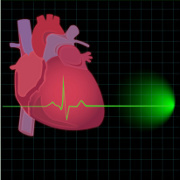One of the warning flags that you may have coronary artery disease (CAD) is angina pectoris (often referred to simply as angina). As plaque develops in your arteries, blood flow slows leaving your heart muscle deprived of adequate amounts of much needed oxygen-rich blood. The result of this lack of oxygen and slow blood flow is chest pain or angina. Persons suffering from angina often describe it as a pressure, tightness or heaviness in the chest. Symptoms of angina are similar to a heart attack. In addition to chest pain, symptoms include: fatigue, nausea, sweating, anxiety, shortness of breath and dizziness. In addition to chest pain, angina sufferers may also experience neck, arms, shoulder, back and jaw pain.
Angina is often triggered by activities that make the heart work harder to pump the blood such as exercise or even unusual levels of stress. Most of the time, if the angina is stable, the symptoms are short-lived (less than five minutes) and disappear after treatment or rest. Since angina is triggered by activities that force the heart to work harder, episodes are often predictable which enables persons affected to better manage the disease and minimize the impact to their quality of life.
Unlike a stable form angina, refractory angina does not respond to medication and is debilitating. The physical activity of persons with refractory angina is severely limited and they often suffer from more advanced, long-term CAD (approximately 10 years). In terms of longevity, refractory angina only results in death in about five percent of all cases. Despite the low mortality rate, persons with refractory angina are at a much greater risk for heart attack. The severe physical limitations, coupled with increased risk of heart attack often lead to an increase in stress levels which only serves to further exacerbate their condition. Although women can (and do) develop refractory angina, it is a male dominated disease which generally affects men over the under the age of 70 years.
Treatments for refractory include lifestyle changes such as losing weight (if obese), quit smoking, and avoiding activities (such as exercise or stressful situations) that put additional strain on the heart and cause it to pump harder. Refractory angina may also be treated with anti-angina medications such as beta blockers or calcium channel blockers to reduce the oxygen demand or nitrates to improve the blood supply. In addition, refractory angina may be treated by revascularization procedures such as PTCA (percutaneous transluminal coronary angioplasty) or CABG (coronary artery bypass graft surgery).
Sources:
Dr. Mike JL DeJongste, René A Tio , and Robert D Foreman, Chronic therapeutically refractory angina pectoris, Heart. 2004 February; 90(2): 225–230, http://www.ncbi.nlm.nih.gov/pmc/articles/PMC1768043/
Angina, Mayo Clinic, 25 Jun 2009, http://www.mayoclinic.com/health/angina/DS00994






Add a Comment1 Comments
Commonly know as angina, Angina pectoris is medical term to describe the temporary severe chest pain due to ischemia of the heart muscle.
February 15, 2011 - 3:04amMicro Vascular Angina
This Comment